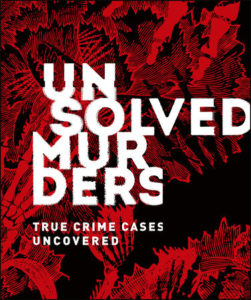__________________________________
THE SKELETON IN THE WOOD
__________________________________
Was she a German spy, the victim of a black magic ritual, or an unfortunate vagrant? Who “Bella” really was is just one of this murder mystery’s unanswered riddles.
More than 75 years have passed since a woman’s skeleton was found stuffed inside a wych elm in a park in Worcestershire, England during World War II. Following this grim discovery, cryptic graffiti asking the question “Who put Bella in the wych elm?” started to appear around the district. Bizarre theories of German spies and witchcraft rituals keep this local legend alive, and the strange and sinister tale of “Bella” still captivates armchair detectives today. Despite a lengthy police investigation and a plethora of plausible—and not so plausible—theories, the identities of the woman nicknamed “Bella,” and that of her killer, remain a mystery.
__________________________________
DOWN IN THE WOODS
__________________________________
The story of the case begins in fittingly dramatic fashion. As dusk was falling on April 18, 1943, four teenage boys were cautiously trudging through Hagley Woods. This stretch of woodland was situated on the grounds of the impressive Hagley Hall estate, which belonged to Lord Cobham. The four boys—Bob Hart, Tom Willetts, Fred Payne, and Bob Farmer—were trespassing. Braving the dangers of getting caught by an angry gamekeeper, they were looking for some excitement to take their minds off the nightly German Luftwaffe’s bombing raids, which were wreaking havoc in Birmingham, their hometown. They had their dogs with them and were hoping to supplement their families’ meagre meat ration with a poached rabbit or two.
After a while, Bob Farmer spotted a wych elm—named for its strange appearance—and decided to climb it, hoping to find a bird’s nest. He clambered up and peeked down into the hollow trunk. A glimmer of white convinced him that he had hit the jackpot. However, the object lodged in the middle of the tree was not a bird’s nest; Bob pulled it out—and found himself staring at a skull, whose empty eye sockets seemed to stare right back at him. At first he thought that the skull was that of an animal—until he noticed clumps of what looked like human hair clinging to it, and crooked teeth protruding from its mouth. The boys fled the woods, promising each other never to tell a soul about what they had found, for fear of getting into trouble.
__________________________________
THE WOMAN IN THE TREE
__________________________________
Despite the promise they had made, the seriousness of their find weighed heavily on 17-year-old Tom Willetts. Shortly after he returned home, he told his parents about what he and his friends had found in Hagley Woods and they alerted the police.
The area was soon cordoned off. Inside the ominous-looking tree, they found a woman’s skeleton. Disturbingly, her hand was missing; the bones were discovered scattered around the tree. A cheap, imitation-gold ring and size 5-and-a-half crepe-soled shoes, were also found a short distance away. Scraps of poor-quality clothing hung from the bones, and a piece of taffeta fabric was stuffed inside the mouth of the skull, indicating that the victim had been suffocated. The medical examiner—Professor James Webster—concluded that the woman was around 35 years old, had irregular teeth in her upper jaw, had light brown hair, and was just 5 feet (1.52 meters) tall. He also determined that the woman had given birth to one child in her lifetime, and estimated that she had been dead for around 18 months.
October 1941 / The estimated time of death for the woman’s skeleton discovered in the wych elm.
Professor Webster’s findings made him certain that the death of this unknown woman was murder, stating: “I cannot imagine a woman accidentally slipping in there, neither do I think it reasonable for a woman to crawl into that place to commit suicide.” He also concluded that the woman had been placed inside the hollow trunk before rigor mortis—the stiffening of the muscles following death—had set in; otherwise the body would have been too stiff to fit inside the narrow tree trunk. Professor Webster also maintained that the victim would most likely have been killed close to the spot where she was found; otherwise the killer would not have been able to transport her body to the tree before rigor mortis set in.
“It was an excellent place for the concealment of a murder and I think it indicates local knowledge.” – Medical Examiner Prof. James Webster
Article continues after advertisement
Following the discovery in the wych elm, Worcestershire police contacted every dentist in the area, hoping that one of them would recognize the woman’s distinctive protruding teeth. They also trawled through piles of missing persons reports to see if any of them matched the description of the deceased. Neither line of inquiry turned up any leads. The investigation then turned toward the personal effects found at the scene. The crepe-soled shoes were traced to the Waterfoot Company, Lancashire, and investigators were able to find the owners of all but six pairs, which had been sold from a market stall in Dudley, a town approximately 11 miles (18 km) from Birmingham.
__________________________________
MYSTERIOUS MESSAGES
__________________________________
The complexity of the investigation caused the trail to become colder with each passing week. The numerous tragedies of war soon distracted public and police attention from the “Tree Murder Riddle”; the woman remained unidentified, and the case was quietly forgotten about. Then, about six months later, mysterious graffiti began to appear in the area.
Christmas 1943 / The first graffiti message appears.
The first message—written in chalk on the side of a house in nearby Old Hill—read: “Who put Luebella down the wych elm?” This was the first time that a name had been connected to the deceased woman. Over the ensuing months, similar messages appeared, all written by the same hand. Gradually, they took on the same word form: “Who put Bella in the wych elm?” The graffiti rang with the implication that somebody knew who killed “Bella,” but appeals by police to find the artist all proved unsuccessful. In the late 1940s, new messages started to appear, asking the same question. Was this a clue—or a taunt? The case became a whodunit that gripped the nation. The combination of the mysterious messages and the lack of an identity for the victim prompted some fanciful theories.
__________________________________
DARK MAGIC
__________________________________
One notion that surfaced early on in the investigation was that “Bella” could have been the victim of a black magic ritual. According to anthropologist Professor Margaret Murray, the fact that “Bella”’s hand was severed from her arm and the bones scattered bore similarities to an occult ceremony known as the “Hand of Glory.” She also concluded that the murder was somehow connected to another case potentially involving witchcraft—the murder of Charles Walton, who was stabbed and pinned to the ground with his own pitchfork in the nearby village of Lower Quinton. Developing the theory that witchcraft was involved, it was noted that the plant, belladonna—also known as deadly nightshade—and witch-hazel are both widely associated with the occult and, according to local legend, so is Hagley Woods. The fact that “Bella” was entombed inside a tree rather than being buried was also indicative of a ritualistic slaying, according to Professor Murray. The theory that “Bella” was executed for some crime against a coven quickly gathered steam and remains a favorite theory even today. Investigators working on the case, however, dismissed the theory, declaring that the bones from “Bella”’s hand had simply been scattered by animal predation.
__________________________________
BELLA THE SPY?
__________________________________
During World War II, several German spies were captured in the UK. As a result, in 1953, the case of Bella and the wych elm attracted a new line of inquiry: war espionage. The Wolverhampton Express and Star received a letter from somebody who identified herself only as “Anna of Claverley.” She claimed to have information on the identity of “Bella” and was interviewed by journalist Wilfred Byford-Jones. According to “Anna,” “Bella” was a member of a spy ring seeking information about the location of local munitions factories that could then be targeted by the Luftwaffe.
“Anna” was later identified as Una Mossop, and she alleged that her RAF pilot husband, Jack Mossop, had witnessed “Bella”’s death. She said that Mossop told her that he had become involved in a spy ring along with a “Dutchman called Van Ralt.” One evening, Van Ralt— accompanied by a woman Mossop believed to be “Bella”—had picked up Mossop in his car. Shortly after, Van Ralt strangled the woman, allegedly because of her spy associations.
Another version of this story claims that Jack Mossop and Van Ralt had been drinking with “Bella” in a local pub when she became drunk and passed out. The two men then placed the woman in the tree to teach her a lesson. When she awoke, she was unable to climb out and perished. However, this theory doesn’t explain the discovery of the taffeta stuffed inside her mouth. Whichever version was reported to the newspaper has become obscured by time, but what is known is that Jack Mossop died in St. George’s Hospital, Stafford, before “Bella”’s body was discovered. Allegedly, recurring nightmares of “Bella”’s skull stuffed inside the tree ultimately led to his mental breakdown. Van Ralt was never found, and investigators considered Mossop’s testimony to be nothing more than hearsay from an estranged wife, told 12 years after the discovery of “Bella.”
In later years, declassified MI5 files gave some weight to the spy theory. The files revealed information concerning a German spy named Josef Jakobs, who was captured after breaking his ankle while parachuting into Cambridgeshire in 1941.[1]
After Jakobs’ arrest, a creased photograph of the glamorous German actress and cabaret singer, Clara Bauerle, was found in his pocket. Jakobs told his interrogators that Bauerle was his lover and that the Third Reich had recruited her as a spy. According to Jakobs, Bauerle had parachuted into the West Midlands in 1941 and disappeared. Could Bauerle have been the woman Una Mossop had mentioned? Josef Jakobs was never able to shed any more light into Bauerle’s fate as he was executed by firing squad in August 1941. However, it is certain that Clara Bauerle could not have been “Bella,” for the simple reason that Bauerle was tall, around 5 feet 10 inches (1.78 meters), whereas “Bella” was only 5 feet (1.52 meters) in height. In addition, in 2016, it was discovered that Clara Bauerle had died in a Berlin hospital in December 1942.
__________________________________
LOST TO TIME
__________________________________
Alongside all of these imaginative theories, there was speculation that “Bella” may have been someone with a transient lifestyle—a person not easily traced in life and thus not particularly missed in death.
In August 2014, BBC Radio 4 broadcast a program[2] that suggested that “Bella” was a prostitute who worked the streets around Hagley Road. According to police files, “Bella” had disappeared in 1941, which would fit the timeline of events. Locals pointed out the fact that gypsies had camped out in the vicinity of Hagley Woods during 1941. Perhaps “Bella” was one of them and had been killed by a member of her own community. Yet another suggestion was that “Bella” was a local barmaid who had been killed by an American GI.
With no concrete evidence to support them, these various theories ultimately led nowhere. One straightforward—and perhaps most probable—hypothesis is that “Bella” was a homeless woman with no loved ones to report her missing. Quite simply, she may have been a woman who just fell through the cracks.
As the decades passed, the mystery continued to grow. The sinister-looking tree, the severed hand, and whispers of witchcraft and espionage have combined to weave this tragic tale of an anonymous woman’s murder into a darkly fascinating legend.
[1] The Independent, August 14, 1999
[2] Punt PI, series 7, “Who Put Bella in the Wych Elm? (BBC Radio 4)
__________________________________
Excerpted from Unsolved Murders by Amber Hunt and Emily G. Thompson, reprinted by permission of DK, a division of Penguin Random House LLC. Copyright © 2019 Dorling Kindersley Limited. All rights reserved. No part of this excerpt may be reproduced or reprinted without permission in writing from the publisher.













